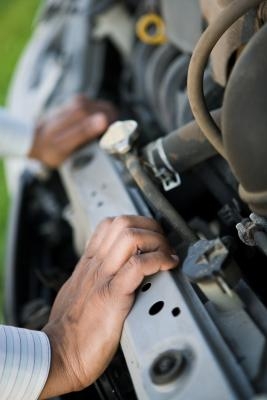
If your Subaru Legacy is experiencing technical difficulties, then it is important to first figure out what is wrong with it rather than throwing time, money and parts at the car hoping that the problem will get fixed. Knowing some of the basic automobile troubleshooting methods, such as using OBD II scanners and listening to different sounds that your car is making will help to prevent bad problems from becoming worse. If you find that you are getting in over your head, as always, take the car to a professional mechanic.
Use an OBD II scanner to read any troubleshooting codes that are being sent from the Legacy's ECM (engine control module). OBD II codes are used to read faults reported by sensors and electronics in the engine and other important systems. The OBD II terminal is a 16-pin connector that is located near the base of the steering column behind a small panel. Plug in the OBD II scanner and turn the ignition key to the accessories position. Look up the fault codes from the scanner on websites such as AutoZone or in commercial repair manuals.
Use a computer with Internet access to look up recalls and TSBs (technical service bulletins) released on your specific mdoel year of the Legacy. Websites for recalls and TSBs include AutoZone, LemonAuto and Automotive. Examples of recalls include the side air-bag systems in the 2005 Legacy and the steering columns in the 2010 model.
Listen to your Subaru Legacy as you are cranking the engine, or while driving. If you notice that your car makes a metallic grinding sound or a slight whirling followed by a "click" when you turn the ignition key, then the starter motor is bad. If you notice metallic pinging coming from the wheels when turning or accelerating, then your CV joints are failing. If you hear loud knocking noises or metallic bearings pinging together when the air conditioner is turned on, then your compressor is failing and you are either low on refrigerant or you have a leak in your car's air conditioning system.
Look underneath your Legacy for any fluid leaks. If you notice large pools of coolant, which looks like an oily, rainbow-colored fluid, then you may have a water pump that is going bad. If you notice red fluid, then your transmission or brake fluid is leaking. If you notice carbon building up on your engine's components or a black, oily substance beneath the vehicle, then you have an oil leak. Continue to add fluids until gaskets and seals are replaced.